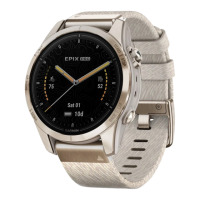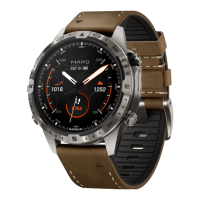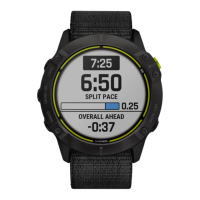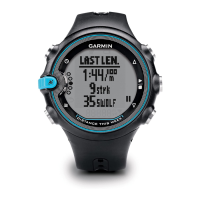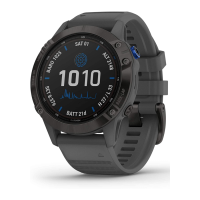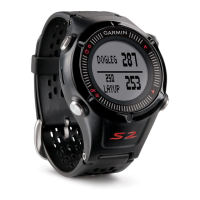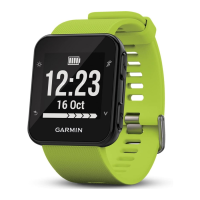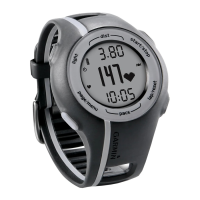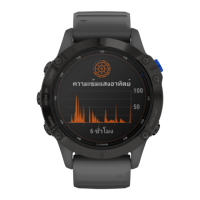Do you have a question about the Garmin EPIX GEN 2 and is the answer not in the manual?
Steps to set up the watch and learn basic features.
Identifies the watch buttons and touchscreen functions.
Instructions for setting multiple alarms on the watch.
How to modify, enable/disable, or delete existing alarms.
Guide to using the stopwatch, including lap timing.
Guide to beginning a new activity, including GPS signal acquisition.
Options available after finishing an activity, like saving or discarding.
Details on various running activities like track or virtual runs.
Defines terms like length, interval, stroke, and swolf.
Lists identified stroke types for pool swimming.
Advice for accurate swimming activity recording.
Steps for using the triathlon activity for segment timing.
Process to set up custom multisport activities.
Guidance on using the watch for indoor training.
How to record climbing routes and difficulty.
Instructions for recording bouldering routes and grading systems.
How to view details of downhill skiing or snowboarding runs.
Steps for tracking climbs and descents in backcountry skiing.
Using HRM-Pro for real-time feedback on skiing performance.
Initial steps to start a golf activity on the watch.
Accessing additional features during a golf round.
Adjusting the pin location on the green for accurate distance.
How to view recorded shot distances from automatic detection.
Steps to plan a jump, including selecting jump type and entering info.
Explains HAHO, HALO, and Static jump types.
Details on inputting jump data like DIP and drop altitude.
How to manage favorite activities for quick access.
Guide to showing, hiding, and changing data screen layouts.
Steps to create new activities or copy existing ones.
Creating and following custom workouts with specific goals.
Downloading workouts from Garmin Connect.
Guiding through multi-step workouts on the device.
Setting up alerts for activities to aid training and awareness.
Enabling automatic detection of elevation changes during activities.
Managing ascent planning and monitoring screens during navigation.
Using tones/vibrations to improve cadence during training.
Sending messages with location to emergency contacts.
Automated message sending upon detecting incidents.
Allowing friends/family to follow your activities in real-time.
Accessing saved activities, stats, and sensor information.
Viewing new personal records achieved during activities.
Options to delete or reset personal records.
Customizing watch face layout, colors, and data.
Activating and modifying Connect IQ or custom watch faces.
Quick information widgets that can be added to the glance loop.
Explains VO2 max. estimates for running and cycling performance.
How the watch estimates target race times based on fitness.
Using heart rate variability to assess overall stress levels.
Real-time assessment of ability to perform during activities.
Setting the language displayed on the watch.
Adjusting time format, zones, and sync options.
Customizing screen brightness, timeouts, and alerts.
Configuring satellite systems for optimal GPS accuracy.
Enabling/disabling wireless communication to save battery.
Accessing the alarm function to set or edit alarms.
Opening the screen to view elevation data.
Viewing current time in multiple additional time zones.
Adding credit/debit cards for contactless payments.
Steps to make payments with the watch.
Instructions on adding up to 10 cards.
Information on the built-in heart rate monitor.
Setting alerts for heart rate exceeding/dropping below targets.
Sending heart rate data to paired devices.
How to manually take a blood oxygen saturation reading.
Options for manual, sleep, or all-day pulse ox measurements.
Troubleshooting steps for inaccurate readings.
Locking the current heading for navigation.
Options for calibrating, display, north reference, and mode.
Steps to manually calibrate the electronic compass.
Configuring calibration, auto-calibration, and sensor modes.
Manual calibration methods for the altimeter.
Configuring barometer plot, storm alerts, and sensor modes.
Using golf club sensors for automatic shot tracking.
Receiving data from a compatible handheld dog tracking device.
Using external monitors for heart rate and running dynamics.
Connecting Bluetooth headphones for music playback.
Steps to search and connect to available sensors.
Using accessories to provide real-time running form feedback.
Adding and using the camera glance for controls.
Instructions to turn on and search for the inReach device.
Controlling a VIRB action camera using the watch.
How to open and navigate the map display.
Saving locations or starting navigation.
Finding and navigating to nearby points of interest.
Customizing map display for activity types.
Customizing map appearance in marine mode.
Choosing which map data layers to display.
Linking supported music providers to the watch.
Syncing audio content via Wi-Fi.
Transferring personal music files via computer.
Navigating music playback on the watch or phone.
Pairing headphones to listen to music.
Overview of features when paired with a compatible phone.
Steps to pair the watch with a phone via Garmin Connect.
Setting up phone notifications on the watch.
Automatic activity syncing via Wi-Fi.
Syncing audio content from third-party providers.
Downloading and installing the latest watch software.
Uploading and saving activities to Garmin Connect.
Viewing detailed activity information and reports.
Choosing fitness goals and training plans.
Connecting watch to computer for data management.
Initiating data sync via controls menu.
Updating personal info for accurate training data.
Understanding fitness comparison based on age and gender.
Explains heart rate zones for measuring intensity.
Customizing heart rate zones based on max HR or reserve.
Allowing the watch to automatically detect HR zones.
Sending messages with location to emergency contacts.
Automated message sending upon detecting incidents.
Real-time activity tracking for friends and family.
Managing saved locations for future navigation.
Steps to navigate to a chosen destination or follow a course.
Returning to the starting point of an activity.
Creating custom routes and navigating them.
Generating round-trip courses based on distance and direction.
Instructions for creating courses in the Garmin Connect app.
Creating a new location by projecting distance and bearing.
Customizing map features and appearance during navigation.
Customizing settings to extend battery life in watch mode.
Adjusting system, activity, and GPS settings for battery extension.
Displaying remaining battery life as a percentage.
Setting the language displayed on the watch.
Adjusting time format, zones, and sync options.
Customizing screen brightness, timeouts, and alerts.
Configuring satellite systems for optimal GPS accuracy.
Information on the display technology and best practices.
Instructions for connecting the watch to a charger.
Proper methods for cleaning the watch case and sensor.
Steps for cleaning and conditioning leather watch bands.
Checking for and installing software and map updates.
Resources for additional product information and support.
Guide to changing the device language.
Tips for troubleshooting phone connection issues.
Pairing and using Bluetooth sensors with the watch.
Tips for maintaining stable Bluetooth headphone connections.
Simple steps to turn the watch off and on.
Restoring the watch to factory default settings.
Steps to get a clear view of the sky for GPS acquisition.
Methods to enhance GPS signal strength.
Troubleshooting inaccurate temperature readings.
Tips for improving step count accuracy.
Resolving discrepancies in step counts.
Troubleshooting inaccurate floor climbing data.
Lists available data fields for activities and their descriptions.
Describes available chart types for activity data visualization.
Explains fields related to compass readings and headings.
Lists fields related to elevation data like ascent and descent.
Describes fields related to tracking climbed and descended floors.
Explains graphical displays for cycling gear and performance metrics.
Lists fields related to swimming pool lengths.
Explains fields used during navigation, like bearing and distance.
Defines various pace metrics for different activities.
Lists fields specific to PacePro training feature.
Defines fields related to rest intervals during swimming.
Explains ground contact time balance and symmetry.
Standard classifications for VO2 max. estimates by age and gender.
Classifications for functional threshold power (FTP) estimates for males.
Classifications for functional threshold power (FTP) estimates for females.
Explains symbols that may appear on device or accessory labels.
Steps to set up the watch and learn basic features.
Identifies the watch buttons and touchscreen functions.
Instructions for setting multiple alarms on the watch.
How to modify, enable/disable, or delete existing alarms.
Guide to using the stopwatch, including lap timing.
Guide to beginning a new activity, including GPS signal acquisition.
Options available after finishing an activity, like saving or discarding.
Details on various running activities like track or virtual runs.
Defines terms like length, interval, stroke, and swolf.
Lists identified stroke types for pool swimming.
Advice for accurate swimming activity recording.
Steps for using the triathlon activity for segment timing.
Process to set up custom multisport activities.
Guidance on using the watch for indoor training.
How to record climbing routes and difficulty.
Instructions for recording bouldering routes and grading systems.
How to view details of downhill skiing or snowboarding runs.
Steps for tracking climbs and descents in backcountry skiing.
Using HRM-Pro for real-time feedback on skiing performance.
Initial steps to start a golf activity on the watch.
Accessing additional features during a golf round.
Adjusting the pin location on the green for accurate distance.
How to view recorded shot distances from automatic detection.
Steps to plan a jump, including selecting jump type and entering info.
Explains HAHO, HALO, and Static jump types.
Details on inputting jump data like DIP and drop altitude.
How to manage favorite activities for quick access.
Guide to showing, hiding, and changing data screen layouts.
Steps to create new activities or copy existing ones.
Creating and following custom workouts with specific goals.
Downloading workouts from Garmin Connect.
Guiding through multi-step workouts on the device.
Setting up alerts for activities to aid training and awareness.
Enabling automatic detection of elevation changes during activities.
Managing ascent planning and monitoring screens during navigation.
Using tones/vibrations to improve cadence during training.
Sending messages with location to emergency contacts.
Automated message sending upon detecting incidents.
Allowing friends/family to follow your activities in real-time.
Accessing saved activities, stats, and sensor information.
Viewing new personal records achieved during activities.
Options to delete or reset personal records.
Customizing watch face layout, colors, and data.
Activating and modifying Connect IQ or custom watch faces.
Quick information widgets that can be added to the glance loop.
Explains VO2 max. estimates for running and cycling performance.
How the watch estimates target race times based on fitness.
Using heart rate variability to assess overall stress levels.
Real-time assessment of ability to perform during activities.
Setting the language displayed on the watch.
Adjusting time format, zones, and sync options.
Customizing screen brightness, timeouts, and alerts.
Configuring satellite systems for optimal GPS accuracy.
Enabling/disabling wireless communication to save battery.
Accessing the alarm function to set or edit alarms.
Opening the screen to view elevation data.
Viewing current time in multiple additional time zones.
Adding credit/debit cards for contactless payments.
Steps to make payments with the watch.
Instructions on adding up to 10 cards.
Information on the built-in heart rate monitor.
Setting alerts for heart rate exceeding/dropping below targets.
Sending heart rate data to paired devices.
How to manually take a blood oxygen saturation reading.
Options for manual, sleep, or all-day pulse ox measurements.
Troubleshooting steps for inaccurate readings.
Locking the current heading for navigation.
Options for calibrating, display, north reference, and mode.
Steps to manually calibrate the electronic compass.
Configuring calibration, auto-calibration, and sensor modes.
Manual calibration methods for the altimeter.
Configuring barometer plot, storm alerts, and sensor modes.
Using golf club sensors for automatic shot tracking.
Receiving data from a compatible handheld dog tracking device.
Using external monitors for heart rate and running dynamics.
Connecting Bluetooth headphones for music playback.
Steps to search and connect to available sensors.
Using accessories to provide real-time running form feedback.
Adding and using the camera glance for controls.
Instructions to turn on and search for the inReach device.
Controlling a VIRB action camera using the watch.
How to open and navigate the map display.
Saving locations or starting navigation.
Finding and navigating to nearby points of interest.
Customizing map display for activity types.
Customizing map appearance in marine mode.
Choosing which map data layers to display.
Linking supported music providers to the watch.
Syncing audio content via Wi-Fi.
Transferring personal music files via computer.
Navigating music playback on the watch or phone.
Pairing headphones to listen to music.
Overview of features when paired with a compatible phone.
Steps to pair the watch with a phone via Garmin Connect.
Setting up phone notifications on the watch.
Automatic activity syncing via Wi-Fi.
Syncing audio content from third-party providers.
Downloading and installing the latest watch software.
Uploading and saving activities to Garmin Connect.
Viewing detailed activity information and reports.
Choosing fitness goals and training plans.
Connecting watch to computer for data management.
Initiating data sync via controls menu.
Updating personal info for accurate training data.
Understanding fitness comparison based on age and gender.
Explains heart rate zones for measuring intensity.
Customizing heart rate zones based on max HR or reserve.
Allowing the watch to automatically detect HR zones.
Sending messages with location to emergency contacts.
Automated message sending upon detecting incidents.
Real-time activity tracking for friends and family.
Managing saved locations for future navigation.
Steps to navigate to a chosen destination or follow a course.
Returning to the starting point of an activity.
Creating custom routes and navigating them.
Generating round-trip courses based on distance and direction.
Instructions for creating courses in the Garmin Connect app.
Creating a new location by projecting distance and bearing.
Customizing map features and appearance during navigation.
Customizing settings to extend battery life in watch mode.
Adjusting system, activity, and GPS settings for battery extension.
Displaying remaining battery life as a percentage.
Setting the language displayed on the watch.
Adjusting time format, zones, and sync options.
Customizing screen brightness, timeouts, and alerts.
Configuring satellite systems for optimal GPS accuracy.
Information on the display technology and best practices.
Instructions for connecting the watch to a charger.
Proper methods for cleaning the watch case and sensor.
Steps for cleaning and conditioning leather watch bands.
Checking for and installing software and map updates.
Resources for additional product information and support.
Guide to changing the device language.
Tips for troubleshooting phone connection issues.
Pairing and using Bluetooth sensors with the watch.
Tips for maintaining stable Bluetooth headphone connections.
Simple steps to turn the watch off and on.
Restoring the watch to factory default settings.
Steps to get a clear view of the sky for GPS acquisition.
Methods to enhance GPS signal strength.
Troubleshooting inaccurate temperature readings.
Tips for improving step count accuracy.
Resolving discrepancies in step counts.
Troubleshooting inaccurate floor climbing data.
Lists available data fields for activities and their descriptions.
Describes available chart types for activity data visualization.
Explains fields related to compass readings and headings.
Lists fields related to elevation data like ascent and descent.
Describes fields related to tracking climbed and descended floors.
Explains graphical displays for cycling gear and performance metrics.
Lists fields related to swimming pool lengths.
Explains fields used during navigation, like bearing and distance.
Defines various pace metrics for different activities.
Lists fields specific to PacePro training feature.
Defines fields related to rest intervals during swimming.
Explains ground contact time balance and symmetry.
Standard classifications for VO2 max. estimates by age and gender.
Classifications for functional threshold power (FTP) estimates for males.
Classifications for functional threshold power (FTP) estimates for females.
Explains symbols that may appear on device or accessory labels.
| Display Size | 1.3 inches |
|---|---|
| Display Resolution | 416 x 416 pixels |
| Display Type | AMOLED |
| Water Rating | 10 ATM |
| GPS | Yes |
| Connectivity | Bluetooth, ANT+, Wi-Fi |
| Memory | 32 GB |
| Dimensions | 47 x 47 x 14.5 mm |
| Compatibility | iPhone, Android |
| Battery Life | Up to 16 days (smartwatch mode) |
| Lens Material | Sapphire Crystal |
| Bezel Material | Titanium |
| Case Material | Fiber-reinforced polymer |
| Sensors | Barometric altimeter, Compass, Gyroscope, Accelerometer, Thermometer, Pulse Ox |
| Smart Features | Music storage, Garmin Pay, Smart notifications |
